Chorley cakes are a much-loved traditional bake from the North-west of England featuring currants wrapped up in shortcrust pastry. They are quick to make and amazing served warm with a little butter.
Although there are similarities, Chorley cakes should not be mistaken for Eccles cakes or Banbury cakes.
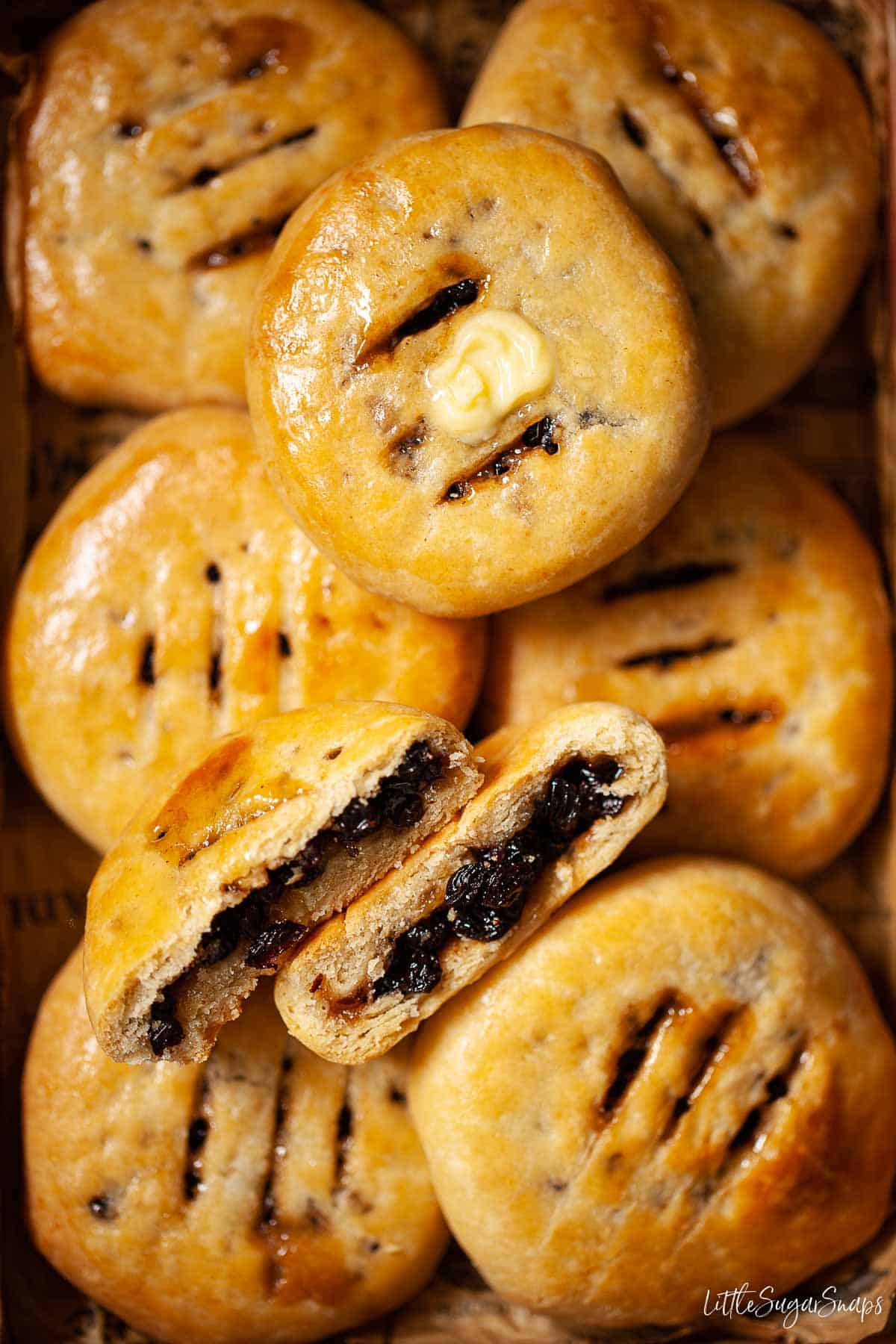
Want to Save This Recipe?
Jump to:
Chorley cakes are a simple and frugal bake originating from the North-west of England in the Lancashire town of (you guessed it) Chorley. They are essentially individual hand pies filled with plump and juicy currants plus a little sugar.
These cakes are a great treat for a mid-morning or afternoon snack, and could even tag along on a picnic or afternoon tea.
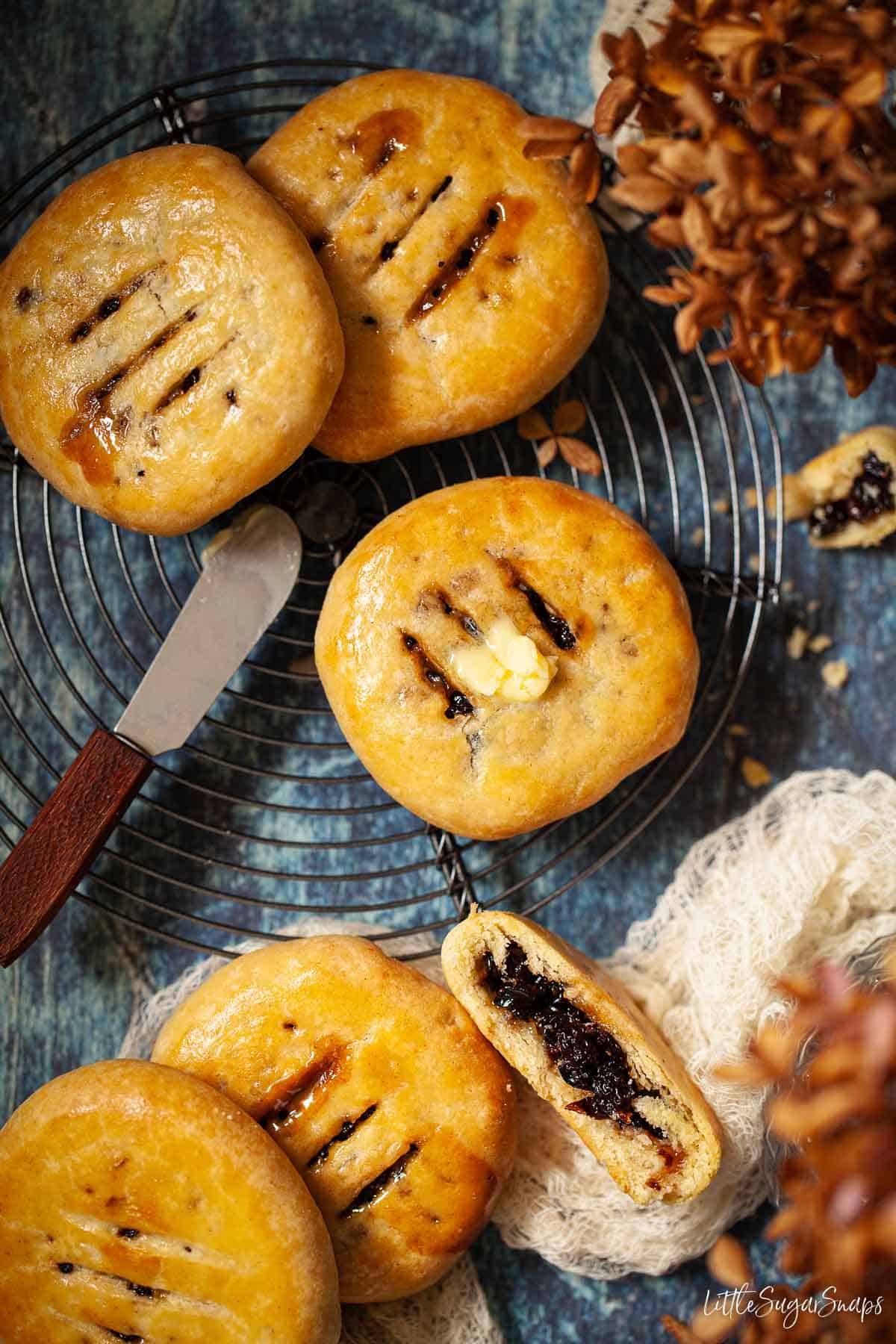
I have to tell you that a dab of butter is insanely good with these Chorley cakes – and I rarely use expressions such as insanely good. It’s not my style, but trust me, this particular combination is pretty special and does warrant breaking out that phrase.
Why Make this Recipe?
Chorley cakes are quick and easy to prepare. They use standard baking ingredients and the result is deeply satisfying.
They are rather like free-form individual pies filled with dried fruit. In fact, there’s no special equipment needed – each pie is shaped by hand from squares of pastry.
If you are in the market for a rustic bake that delivers bags of flavour, this is a great recipe to make.
What’s the difference between Chorley Cakes and Eccles Cakes?
Although Chorley cakes are a close relation of the Eccles cake there are a couple of important differences:
- Chorley cakes use a form of shortcrust pastry to encase the fruit filling whilst Eccles cakes use flaky pastry
- There is significantly less sugar inside of the Chorley cake. It’s still plenty sweet enough, but the difference between the two bakes is noticeable
And incidentally, a Sad cake is a large Chorley cake.
All are absolutely delicious (hard to stop eating) bakes in their own right, simply served with a cup of tea. But a slick of butter or a hunk of Lancashire cheese can accompany them all to great effect.
Ingredients notes
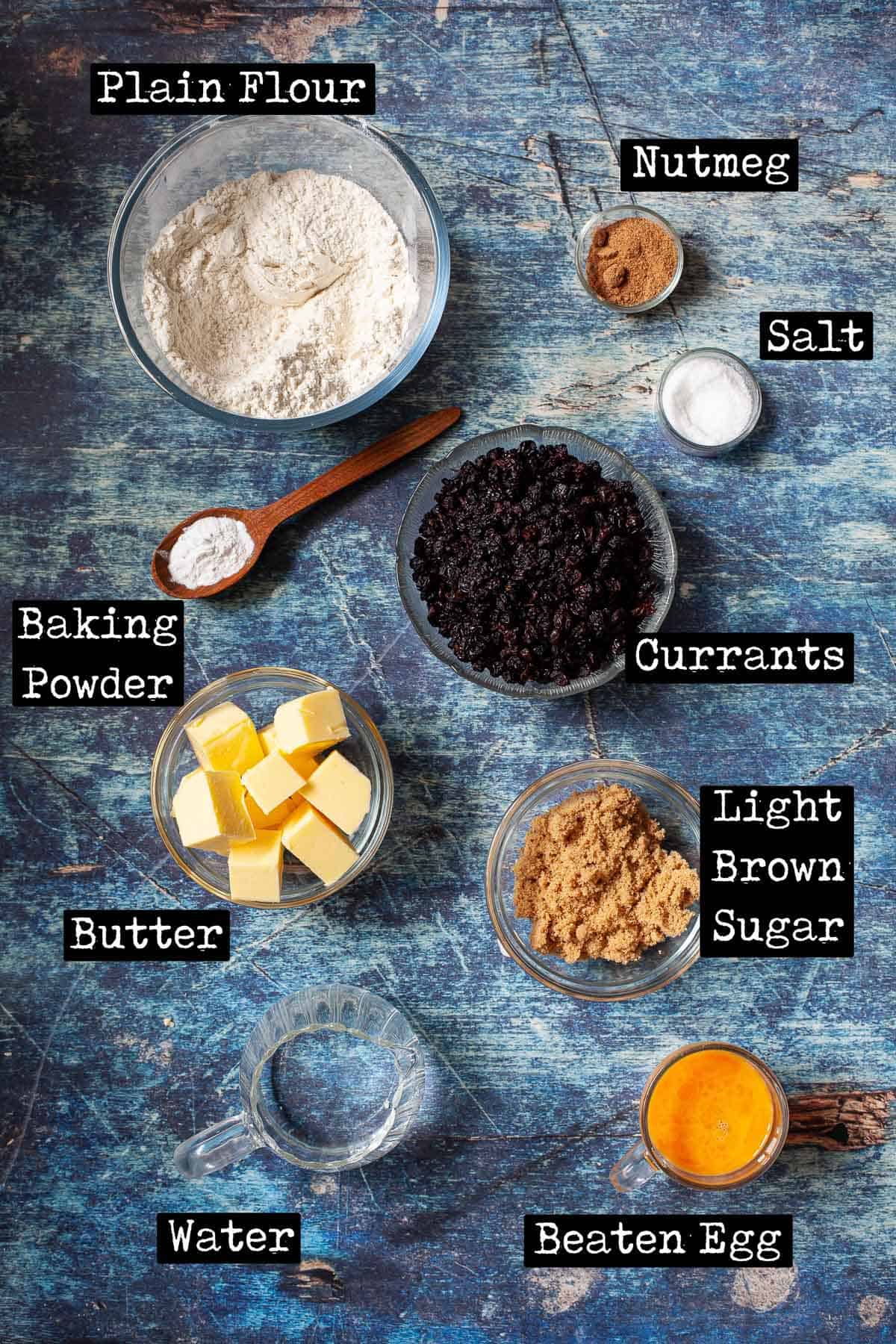
Rather unusually, the shortcrust pastry contains baking powder, which serves to lift and aerate it very slightly. The result is a tender, slightly flaky pastry. It’s well worth including this ingredient.
Using currants rather than raisins or sultanas is of paramount importance in this recipe. Chorley cakes are, by nature, a humble bake and it’s the intense, tangy bite of the currant that makes this bake magnificent.
Choose quality fruit, such as Vostizza currants and don’t be tempted to use any fruit that has been lingering, opened, at the back of the cupboard. The fruit will not be at its best. Instead, use only freshly opened, plump and juicy currants for this recipe. It makes all the difference.
Step by step instructions
1. Put the flour, baking soda and salt into a bowl and stir briefly. Cube the butter, add to the bowl and rub in
2. Pour in ¾ of the water and mix, with a blunt knife, to a soft dough, adding more water as necessary (do not add so much that the dough turns sticky)
3. Bring the dough together with your hands then turn out onto a lightly floured worktop and knead briefly until smooth. Flatten slightly, wrap and chill for 30 minutes to allow the glutens in the pastry to relax
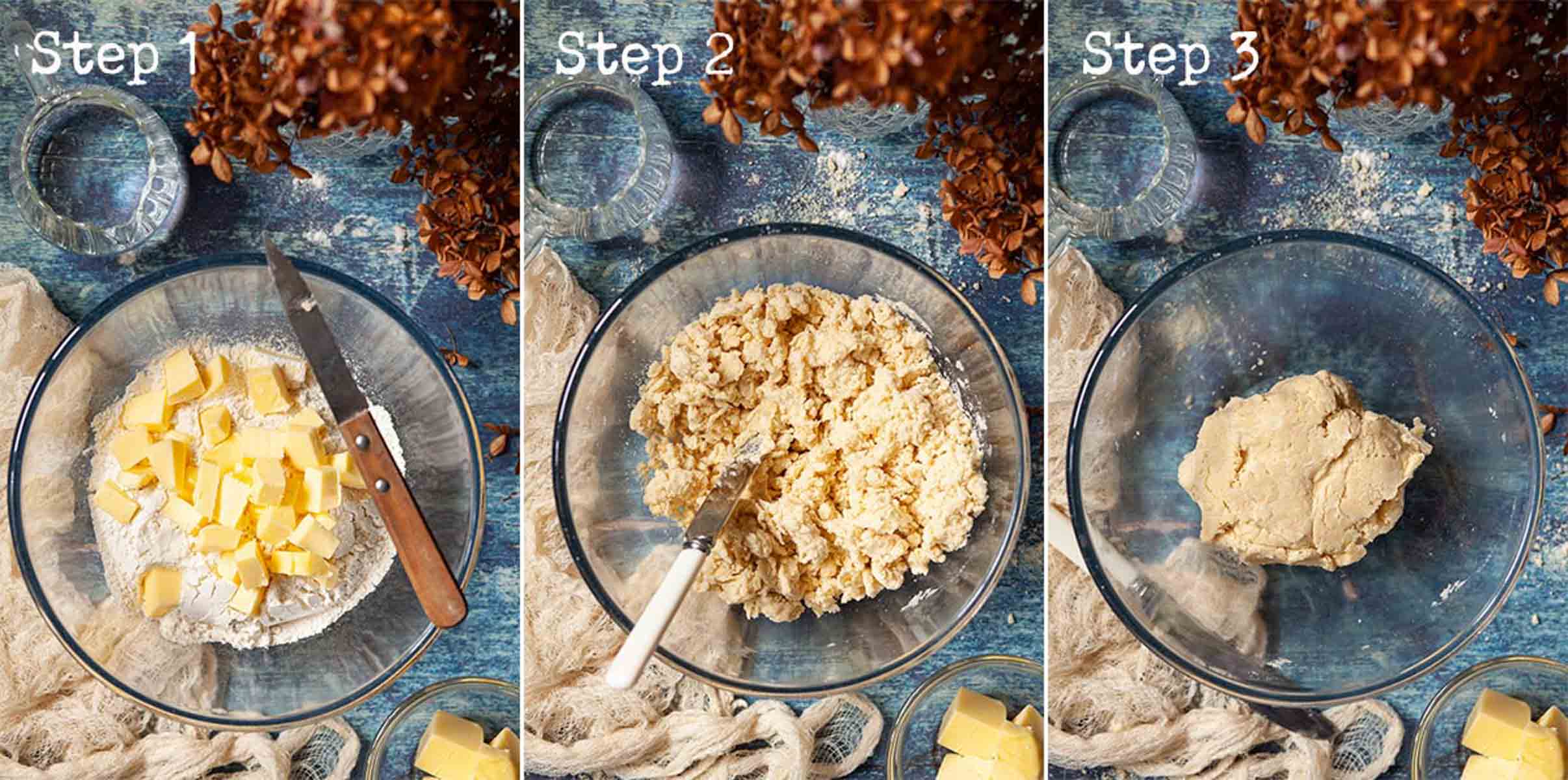
4. When ready to assemble make the filling: put the currants, sugar and nutmeg into a bowl, melt the butter and stir until combined
5. Roll the pastry out into a rectangle approx 18cm x 36 cm. Trim off any straggly edges then divide into 8 squares measuring 9cm x9cm. If the dough does not roll out to these dimensions, ensure that is around 3mm deep, cut as many squares as possible, then press the leftover dough back together and re-roll to cut further squares
6. Divide all of the filling between the eight squares of pastry dough, using a spoon to pile it into the centre of each one
7. Dip a pastry brush in some beaten egg and run it around the edges of 1 square of pastry to dampen. Gather two opposite corners of pastry up towards the centre and press together lightly. Gather the other corners up to the centre too, pushing the filling back into the centre as you do so. When all corners are gathered gently press the pastry seams together and draw the edges into the centre to form a circle

8. When all edges are sealed, turn the pastry over, so the seams are underneath and use lightly floured hands to form a circular shape. Use a rolling pin to slightly flatten each pastry (roll lightly once, then rotate the pastry and roll again. Repeat as necessary until the fruit becomes visible (each Chorley cake should be around 6-7cm at this stage)
9. Repeat steps 7-8 with the remaining squares of dough
10. Brush each top with a little beaten egg and use a sharp knife to cut three slashes across the top of each cake
11. Bake for 12-15 minutes until golden
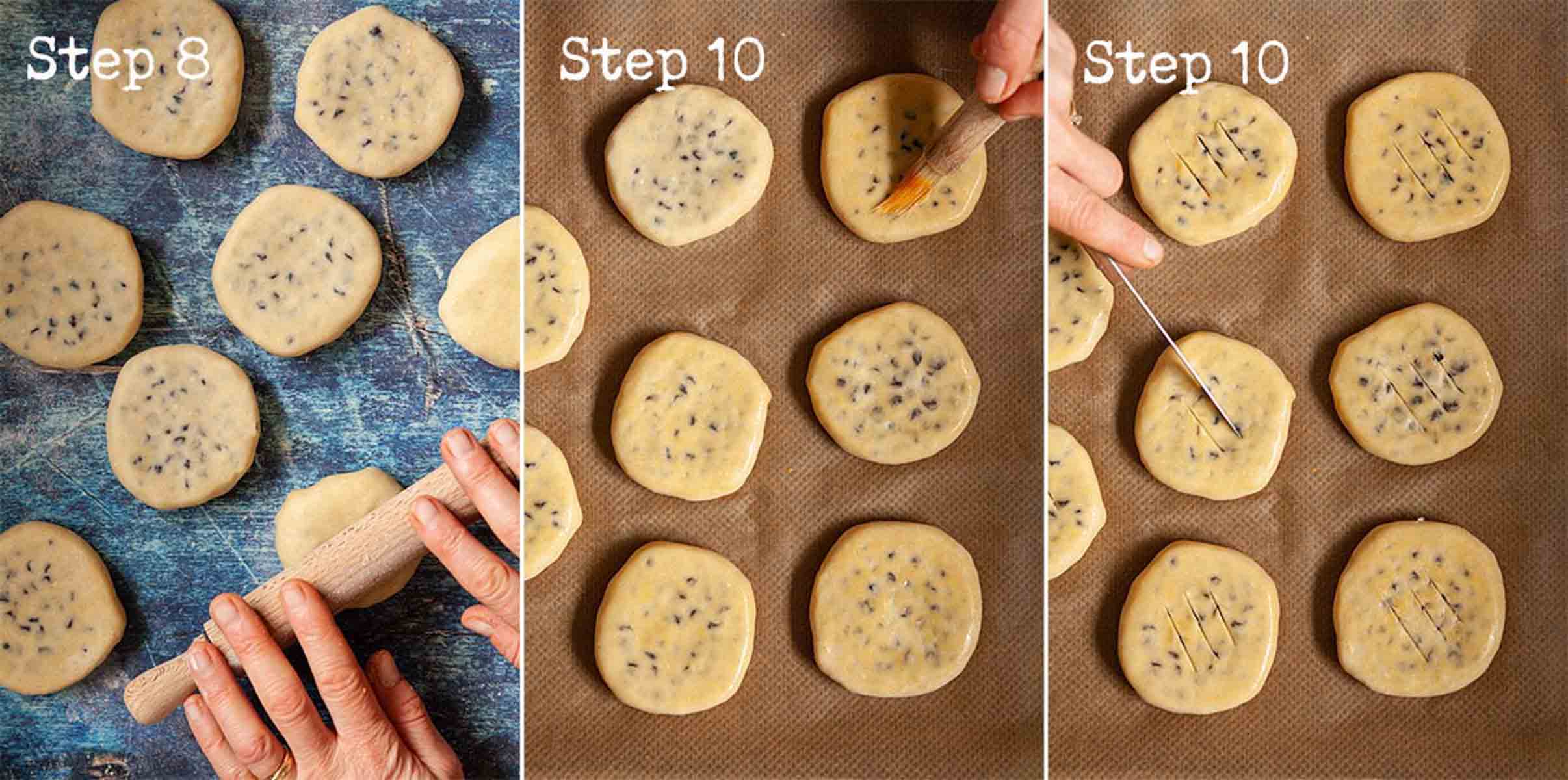
Expert tips
- Never skip the chilling of the pastry dough. It is easier to handle when sufficiently chilled and will bake to a superior texture
- Store-bought shortcrust pastry can be used in place of homemade. Keep in mind that it is unlikely to contain baking powder so the texture will be slightly different
- Each pastry square needs to be approximately 9×9 cm in order to hold the filling, so measuring the pastry before cutting is a good idea
- Ideally, roll your pastry into a rectangle approx 18 cm x 36cm – so that the 8 squares can be cut from it. But if your pastry goes wonky, just roll to 3mm deep before cutting squares and then re-roll to allow more squares to be cut
- It’s best to divide the filling across all squares before beginning to seal any of them. Doing so means that you can ensure each cake gets a good amount of filling and none is leftover
- Seal one square at a time to avoid the egg drying out/ turning the pastry soggy
- When sealing the pastry if some of the filling mixture falls out just push it back in and continue to seal, leaving no gaps
- Once sealed and shaped, Chorley cakes do need to be rolled/ pressed (either with a rolling pin or the flat of a hand) until the dried fruit becomes visible. Make 2-3 light rolls/ presses across the entire of the cake, rotating slightly between each roll/ press to help keep a circular shape to the pastries
- It’s best to reheat Chorley cakes in the oven (150C/300F/ GM2) for 5 minutes. Avoid reheating in a microwave as doing so will turn the pastry soggy
Frequently asked questions
Yes you can. The pastry will be more typical shortcrust, perhaps not quite so tender and flaky, but it will suffice.
If using store-bought pastry (perfectly acceptable) then it’s unlikely such pastry will contain baking powder.
Yes – cinnamon and nutmeg would both fit in well here. Try ¾ teaspoon cinnamon and ¼ teaspoon nutmeg.
For a less than traditional Chorley cake try adding in some finely diced stem ginger.
Chorley cakes can be frozen either before or after they have been baked.
To freeze before baking, prepare fully, up to, and including, the point of adding the egg wash. Open freeze the pastries on a baking sheet lined with parchment and when solid, slide into a freezer container or bag, label and keep frozen for up to 2 months. Bake from frozen: lay them onto a lined baking sheet and cook for 20-25 minutes at the temperature specified in the recipe card below.
If already cooked, let cool completely and freeze as soon as possible. Let defrost fully, then reheat for 5-10 minutes to re-crisp the pastry.
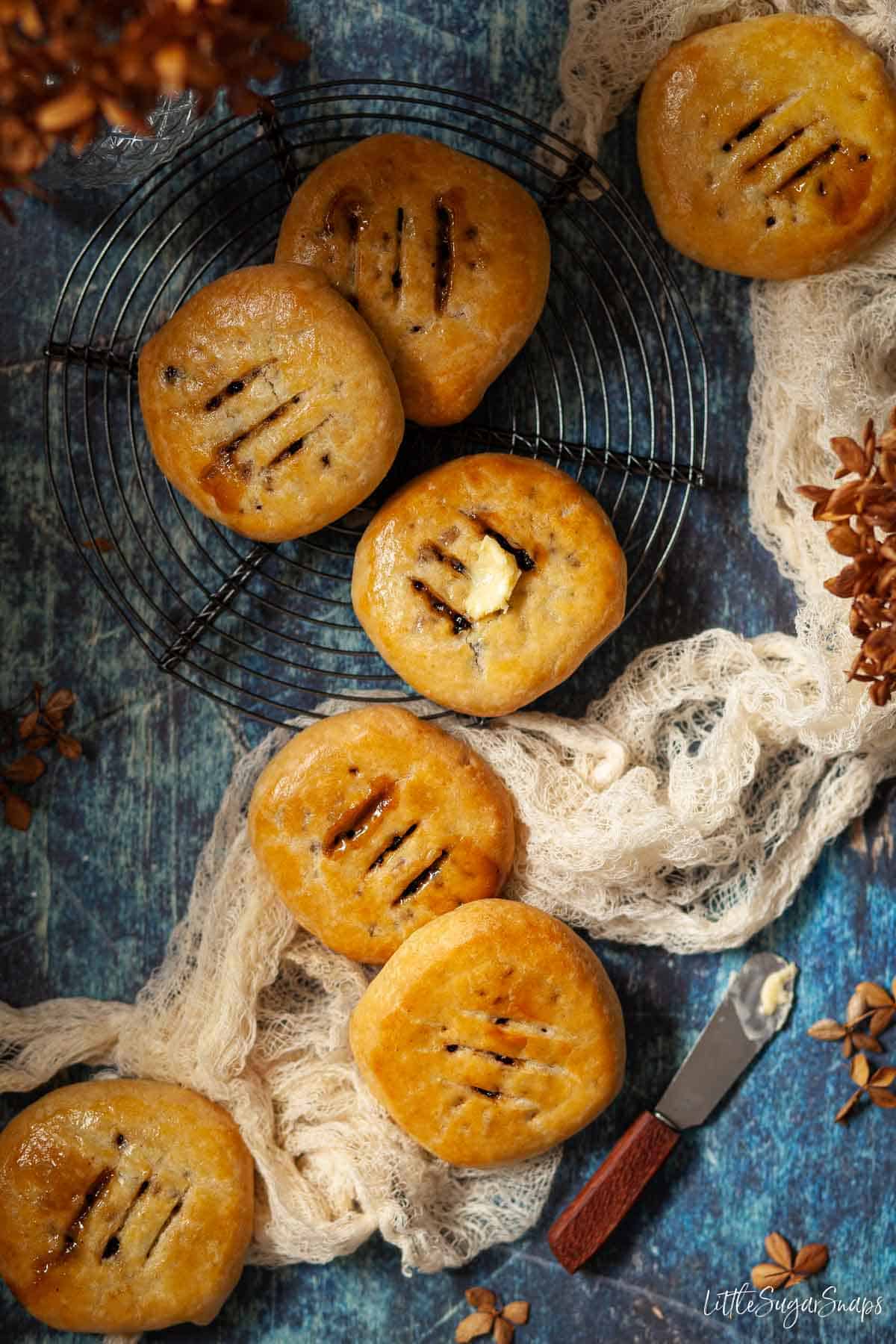
More sweet pastry bakes
Have you made this recipe for Chorley cakes? Please let me know how you got along by leaving a review.
Stay in touch: sign up to receive LittleSugarSnaps newsletters to hear when new recipes are published. Or follow me on social media:
📖 Recipe
Want to Save This Recipe?
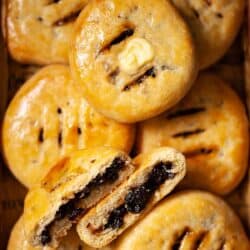
Chorley Cakes
Ingredients
For the Pastry (or use 300g storebought – see notes)
- 200 g Plain flour all-purpose
- ¾ teaspoon Baking powder
- ¼ teaspoon Salt
- 100 g Butter
- 3 tablespoons Cold water
For the Filling
- 200 g Currants
- 50 g Light brown sugar
- ⅛ teaspoon Nutmeg
- 50 g Butter
- A little beaten egg – for glazing
Instructions
- Put the flour, baking soda and salt into a bowl and stir briefly. Cube the butter, add to the bowl and rub in
- Pour in 2 tablespoons of the water and mix, with a blunt knife, to a soft dough, adding more water only if necessary (do not add so much that the dough turns sticky)
- Bring the dough together with your hands then turn out onto a lightly floured worktop and knead briefly until smooth. Flatten slightly, wrap and chill for 30 minutes to allow the glutens in the pastry to relax
- Meanwhile preheat the oven to 200C/ 400F/ GM 6 and line a baking sheet with baking parchment
- When ready to assemble make the filling: put the currants, sugar and nutmeg into a bowl, melt the butter and stir until combined
- Roll the pastry out into a rectangle approx 18cm x 36 cm. Trim off any straggly edges then divide into 8 squares measuring approximately 9cm x9cm. If the dough does not roll out to these dimensions, ensure that is around 3mm deep, cut as many squares as possible, then press the leftover dough back together and reroll to cut further squares – aim for 8 squares in total
- Divide all of the filling evenly between the eight squares of pastry dough, using a spoon to pile it into the centre of each one
- Dip a pastry brush in some beaten egg and run it around the edges of 1 square of pastry to dampen. Gather two opposite corners of pastry up towards the centre and press together lightly. Gather the other corners up to the centre too, pushing the filling back into the centre as you do so. When all corners are gathered gently press the pastry seams together and draw the edges into the centre to form a circle
- When all edges are sealed, turn the pastry over, so the seams are underneath and use lightly floured hands to form a circular shape. Use a rolling pin to slightly flatten each pastry (roll lightly once, then rotate the pastry and roll again. Repeat as necessary until the fruit becomes visible (each Chorley cake should be around 6-7cm at this stage)
- Repeat steps 7-8 with the remaining squares of dough then brush each top with a little beaten egg and use a sharp knife to cut three slashes across the top of each cake
- Bake for 12-15 minutes until golden
Notes
Cooking Tips
- Storebought shortcrust pastry can be used in this recipe, but as it is unlikely to contain baking powder, the texture will be very slightly different
- Never skip the chilling of the pastry dough. It is easier to handle when sufficiently chilled and will bake to a superior texture (especially on a hot day)
- Each pastry square needs to be approximately 9×9 cm in order to hold the filling, so measuring the pastry before cutting is a good idea
- Ideally roll your pastry into a rectangle approx 18 cm x 36cm – so that the 8 squares can be cut from it. But if you pastry goes wonky, just roll to 3mm deep before cutting squares and then re-roll to allow more squares to be cut
- It’s best to divide the filling across all squares before beginning to seal any of them. Doing so means that you can ensure each cake gets a good amount of filling and none is leftover
- Seal one square at a time to avoid the egg drying out/ turning the pastry soggy
- When sealing the pastry if some of the filling falls out just push it back in and continue to seal, leaving no gaps
- Once sealed and shaped, Chorley cakes do need to be rolled/ pressed (either with a rolling pin or the flat of a hand) until the dried fruit becomes visible. Make 2-3 light rolls/ presses across the entire of the cake, rotating slightly between each roll/ press to help keep a circular shape to the pastries. It’s best to proceed lightly with several rolls rather than taking a heavy-handed approach with will lead to misshapen cakes
- It’s best to reheat Chorley cakes in the oven (150C/300F/ GM2) for 5 minutes. Avoid reheating in a microwave as doing so will turn the pastry soggy
- The baking powder helps achieve a wonderfully tender pastry, noticeably different from normal shortcrust pastry. Though it’s not a typical pastry ingredient, include it if you can
Serving Suggestion
Chorley cakes are best eaten fresh and within 48 hours. Try serving them just warm with a knob of butter on the top. They can be reheated in a warm oven (150C/ 300F/ GM 2) for 5 minutes.Freezing Instructions
Chorley cakes can be frozen either before or after they have been baked.To freeze before baking, prepare fully, up to, and including, the point of adding the egg wash. Open freeze the pastries on a baking sheet lined with parchment and when solid, slide into a freezer container or bag, label and keep frozen for up to 2 months. Bake from frozen: lay them onto a lined baking sheet and cook for 20-25 minutes at the temperature specified in the recipe card below.
If already cooked, let cool completely and freeze as soon as possible. Let defrost fully, then reheat for 5-10 minutes to re-crisp the pastry.

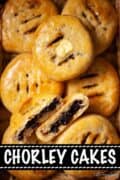


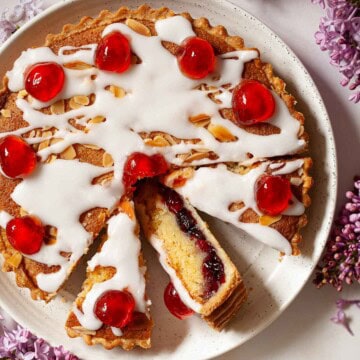
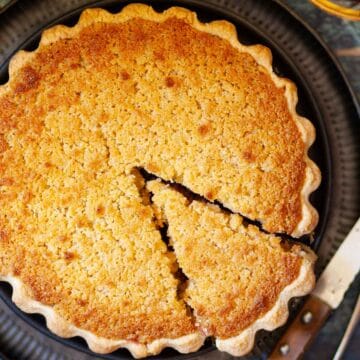
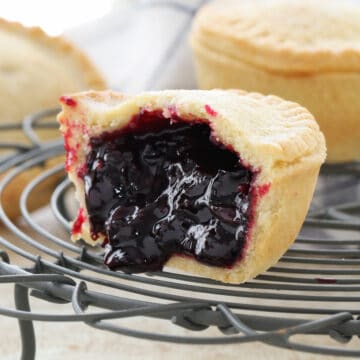
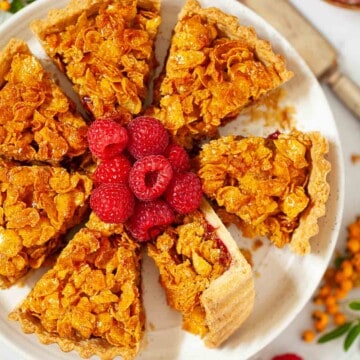
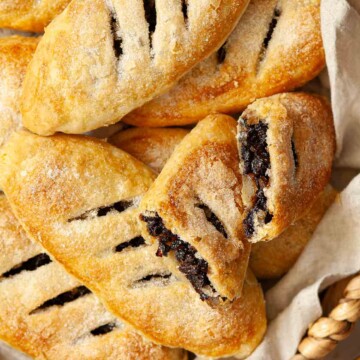
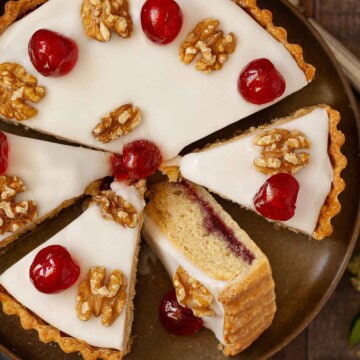

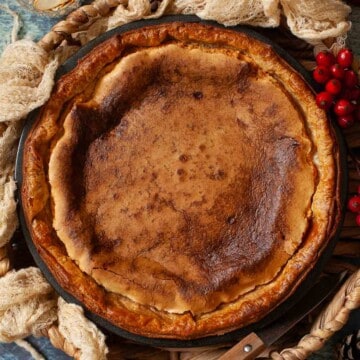
JCE
Lovely recipe – only put 1tbsp of brown sugar in as currents quite sweet enough.
Husband said best Chorley cake he’d ever had.
Jane Saunders
Oh my! Janice, thankyou so much for your feedback – it’s really appreciated and you made my day!
Rachael
Love Chorley cakes and this recipe is full of great tips! I wondered if I bake them from frozen (raw), could they then be refrozen baked? I accidentally made too many! And if so, would you follow the step of reheating for ten mins before eating? Thanks.
Jane Saunders
Hi Rachael, I’m so pleased you’ve enjoyed the recipe. I don’t see why they can’t be frozen raw, baked and then refrozen, but the beauty of freezing them raw is that you can pull them out as required, so you may not nreed to worry about re-freezing once cooked at all. If you do freeze them after cooking, I’d suggest letting them defrost at room temp for 1-2 hours and then reheating as instructed. Hope this answer helps.
David
Brilliant. Not a patch on the bought ones. This is now one of my prized recipes. Thank you for sharing.
Jane Saunders
I’m so pleased you’re enjoying them – thank you for taking the time to let me know how you got along with my recipel.
Aggie
I couldn’t find currants and so used soaked dates with a little melted butter, and chopped pistachio, with nutmeg, allspice and cinnamon added. Magic! And the pastry is super short. I’m making a second batch now they were so good. Thanks for great recipe.
Jane Saunders
Ah fantastic – sounds like a tasty combination.
Belinda
You did not put the proper measurement for water in regards to the pastry.
Says 3/4? 3/4 what?
Please fix? Thanks!
Jane Saunders
Oh gosh, thanks for bringing this to my attention. Fixing now!
Sondra Keller
Sounds really good — but if I tried, would have to convert recipe from grams, etc.
W A Y too much trouble. thx anyway.
Jane Saunders
Hi Sondra, glad you like the look of them. I’d accidentally omitted the conversion to ounces and have now put those in – not sure if that helps you out or not? I’ve not converted to cups for this recipe as the measures do not translate to sensible cup measurements that people would be able to use. If you don’t have them already I highly recommend a set of digital scales – they are inexpensive (approx £10) and means you’ll be able to make recipes like this that are listed in grams going forward. All the best – Jane.
Monique
Had never heard of these!Thank you
Jane Saunders
It’s a regional British bake (a bit overshadowed by others) so it’s good to see it getting a moment in the spotlight around the world whenever somebody reads this post 🙂